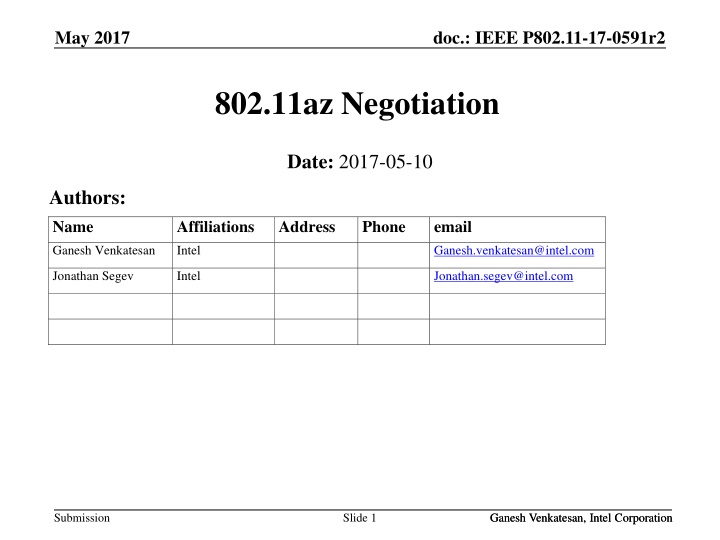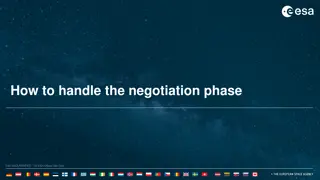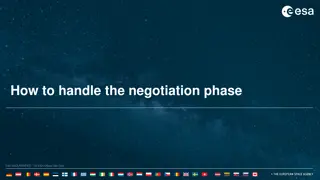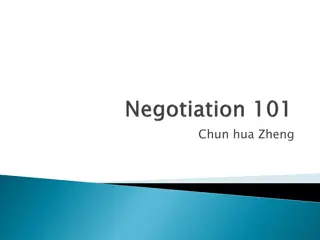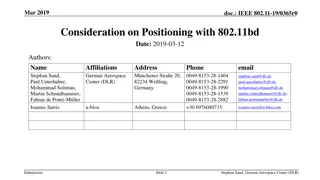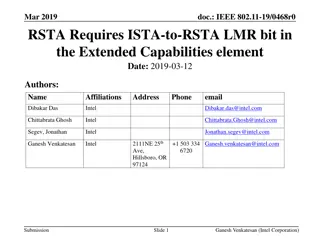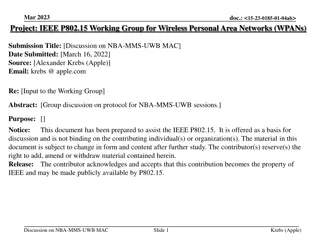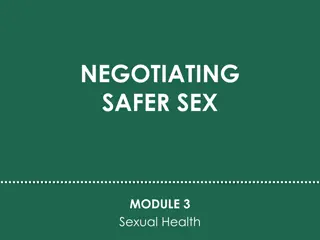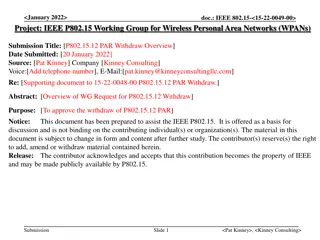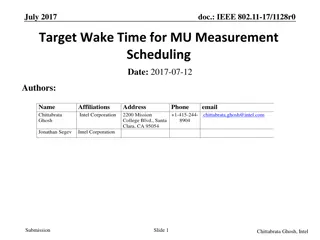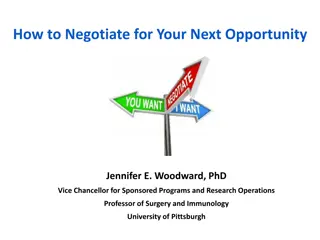Detailed Analysis of IEEE P802.11-17-0591r2 Negotiation Phase for 802.11az Protocol
This document delves into the intricacies of the Negotiation Phase of the 802.11az Protocol, focusing on developing specific parameters that require negotiation, reaching a consensus position, and creating corresponding Specification Framework Document content. Various negotiation options and the roles of Initiator and Responder in the ranging protocols are discussed in detail.
Download Presentation

Please find below an Image/Link to download the presentation.
The content on the website is provided AS IS for your information and personal use only. It may not be sold, licensed, or shared on other websites without obtaining consent from the author.If you encounter any issues during the download, it is possible that the publisher has removed the file from their server.
You are allowed to download the files provided on this website for personal or commercial use, subject to the condition that they are used lawfully. All files are the property of their respective owners.
The content on the website is provided AS IS for your information and personal use only. It may not be sold, licensed, or shared on other websites without obtaining consent from the author.
E N D
Presentation Transcript
May 2017 doc.: IEEE P802.11-17-0591r2 802.11az Negotiation Date: 2017-05-10 Authors: Name Affiliations Address Phone email Ganesh Venkatesan Intel Ganesh.venkatesan@intel.com Jonathan Segev Intel Jonathan.segev@intel.com Submission Slide 1 Ganesh Venkatesan, Intel Corporation Ganesh Venkatesan, Intel Corporation
May 2017 doc.: IEEE P802.11-17-0591r2 Motivation/Background Develop next level of details for the Negotiation Phase of the 802.11az Protocol Based on document 17/0141; and some offline discussions Move forward with parameters that are clearly the ones that need to be negotiated Others could be added upon further discussion/consensus Some may be removed Some of the <TBD>s in this presentation will be resolved as the details of the third step, Ranging/Measurement develop The main focus of this presentation is to get to a consensus position on the negotiation phase and develop corresponding Specification Framework Document content Submission Slide 2 Ganesh Venkatesan, Intel Corporation Ganesh Venkatesan, Intel Corporation
May 2017 doc.: IEEE P802.11-17-0591r2 Terminology Responder and Initiator FTM Initiator sends iFTMR and Responder sends FTM Responder provides its LCI/Location Civic information Initiator estimates Range/Position Capabilities FTM Responder the device can play the role of a responder for all supported ranging protocols indicated by setting bit-70 of the Extended Capabilities element FTM Initiator the device can play the role of an initiator for all supported ranging protocols indicated by setting bit-71 of the Extended Capabilities element Ranging Protocols Time of Flight (ToF) measurement; may be extended for others (needs more discussion) IEEE 802.11-2016 Fine Timing Measurement Prototocol (FTM) VHT NDP Sounding-based .11az protocol (VHTz) HEW NDP Sounding-based .11az protocol (HEWz) Ranging protocol while operating in 60 GHz (11AYz) Slide 3 Submission Ganesh Venkatesan, Intel Corporation Ganesh Venkatesan, Intel Corporation
May 2017 doc.: IEEE P802.11-17-0591r2 Negotiation Options Option -1 Discover Capabilities Negotiate Security -- optional Negotiate .11az parameters Measurement Pros Allows for LCI to be protected Protects parameter negotiation Cons Additional exchange Option-2 Discover Capabilities Negotiate Security and .11az parameters Measurement Pros Measurement starts early LCI can be protected if sent in a separate management frame Cons Does not protect parameter negotiation Increased time to get hold of LCI Security keys may not be usable Ganesh Venkatesan, Intel Corporation Ganesh Venkatesan, Intel Corporation for outside-the-context of FTM Submission Slide 4
May 2017 doc.: IEEE P802.11-17-0591r2 Straw Poll-1 (Security Negotiation) Which of the following Security negotiation options do you support? Option-1: a separate step within the Negotiation Phase 11 Option-2: an integrated Negotiation Phase 1 Abstain: 2 Results: Submission Slide 5 Ganesh Venkatesan, Intel Corporation Ganesh Venkatesan, Intel Corporation
May 2017 doc.: IEEE P802.11-17-0591r2 Motion-1 Move to adopt the security setup for 802.11az to be Negotiated in a separate optional step prior to the 802.11az protocol parameter negotiation Note that in lieu of security negotiation, keys derived using an out- of-band mechanism may be used to secure the exchange between the initiator and the responder And include it in the 802.11az SFD (Cl. 3.2 Protocol Description), granting the SFD Editor editorial license. Moved: Ganesh Venkatesan Seconded: Nehru Bhandaru Result: Y: 15 N: 0 A: 1 (Motion Passes) Submission Slide 6 Ganesh Venkatesan, Intel Corporation Ganesh Venkatesan, Intel Corporation
May 2017 doc.: IEEE P802.11-17-0591r2 Negotiation From among the discovered Responders, the STA selects a subset (Rn) for negotiation To each of the member of Rn, the STA sends an initial FTM request (iFTMR) which includes at least one of: A FTM Parameters element as described in REVmc D8.0 which is a set of parameters that the STA proposes to use if it executes the FTM ranging protocol with the corresponding responder, A NGP Parameters element which is a set of parameters that the STA proposes to use if it executes either the VHTz or the HEWz ranging protocol with the corresponding responder NGP Parameters elements may include an optional VHTz , an optional HEWz and/or an optional 11AYz subelement(s) Submission Slide 7 Ganesh Venkatesan, Intel Corporation Ganesh Venkatesan, Intel Corporation
May 2017 doc.: IEEE P802.11-17-0591r2 Negotiation (cont d) The initiator indicates one of the following: No preference for the ranging protocol (the responder selects one based on its current operating conditions) A preferred ranging protocol (the responder may select a different ranging protocol if it has no resources to support the preferred one) The responder Chooses one of the ranging protocols and responds with the corresponding {FTM, NGP} parameters element in the initial FTM (in response to the initial FTM request), or Rejects the initial FTM request and optionally includes {FTM. NGP} parameters element indicating the parameter set that it can potentially support, if requested Submission Slide 8 Ganesh Venkatesan, Intel Corporation Ganesh Venkatesan, Intel Corporation
May 2017 doc.: IEEE P802.11-17-0591r2 .11az Negotiation: Parameters to Negotiate Determine specific capabilities, configuration Number of antennas LCI/Civic (with LCI includes offsets to individual antenna positions) What measurements are supported ToF, Angular, etc Security key negotiation/derivation protocols Resource Allocation When are results expected? (immediate/delayed depending on Initiator capabilities) MU STA ID assignment SU/MU mode dynamics Preferred Mode of Measurement Protocol execution E.g., Band and Channel Width to use, number of measurements in a burst, etc. Measurement Rate Submission Slide 9 Ganesh Venkatesan, Intel Corporation Ganesh Venkatesan, Intel Corporation
May 2017 doc.: IEEE P802.11-17-0591r2 .11az Negotiation Leverage FTM approach Initiator proposes, Responder approves/disapproves On approval by Responder, use the resulting parameters to execute the ranging protocol with the Responder Proposed Representation Leave FTM Parameters element as is Define a new Security Parameters element that applies to all the ranging protocols proposed/approved Define a NGP Parameters element that includes parameters relevant to both VHTz and HEWz ranging protocols Submission Slide 10 Ganesh Venkatesan, Intel Corporation Ganesh Venkatesan, Intel Corporation
May 2017 doc.: IEEE P802.11-17-0591r2 Initial FTM Request/Initial FTM Exchange (update based on outcome of Straw Poll-1) Categor y Public Action Trigger LCI Location Civic Measurement Request (optional) Fine Timing Measurement Parameters (Mandatory) (optional) NGP Measureme nt Request (optional) Parameters (optional) 1 1 1 variable variable 11 12 Octet s Status Indication Value Reserved Number of Bursts Exponent Burst Duration Min Delta FTM Partial TSF Timer Bits 2 5 1 4 4 8 16 Partial TSF Timer No Preference ASAP Capable ASAP FTMs per Burst Reserved Format and Bandwidth Burst Period bits 1 1 1 5 2 6 16 Submission Slide 11 Ganesh Venkatesan, Intel Corporation Ganesh Venkatesan, Intel Corporation
May 2017 doc.: IEEE P802.11-17-0591r2 Security Parameters Element (TBD) Needed only if option-2 wins Applies to all ranging protocols including IEEE 802.11- 2016 FTM Define this based on proposals presented so far Refine as the Security Proposals become more concrete Submission Slide 12 Ganesh Venkatesan, Intel Corporation Ganesh Venkatesan, Intel Corporation
May 2017 doc.: IEEE P802.11-17-0591r2 NGP Parameters Element Element ID (255) Length Element ID Extension NGP Parameters VHTz specific subelement (optional) HEWz specific subelement (optional) <tbd> 11AYz Specific subelement (optional) Octets 1 1 1 <tbd> <tbd> Status Indication Value Reserved Number of Antennas Measurements Supported Measurement Rate Min Response Time Bits 2 5 1 4 4 8 8 Max Response Time Immediate Response Capable Immediate Response Reserved Format and Bandwidth Antenna Configuration Reserved bits 8 4 1 5 6 4 12 Submission Ganesh Venkatesan, Intel Corporation Ganesh Venkatesan, Intel Corporation Slide 13
May 2017 doc.: IEEE P802.11-17-0591r2 NGP Parameters element details (a set to start discussions with) Number of Antennas Measurements Supported ToF, AoA, AoD Indicates support in all Ranging protocols If a measurement is not supported in all ranging protocols, it is disabled here, and a corresponding bit is enabled in the ranging protocol-specific sub-element Min Response Time Minimum time (TUs) to respond, reserved if Immediate Response is Enabled Max Response Time Max time (TUs) to respond. Reserved if Immediate Response is Enabled Immediate Response Capable for each supported measurement type What does response mean? Immediate Response Enabled/Disabled Reserved in Request Submission Slide 14 Ganesh Venkatesan, Intel Corporation Ganesh Venkatesan, Intel Corporation
May 2017 doc.: IEEE P802.11-17-0591r2 VHTz Specific subelement (work in progress) Measurements Supported Immediate Response Capable Pre-AID assigned to the Initiator Submission Slide 15 Ganesh Venkatesan, Intel Corporation Ganesh Venkatesan, Intel Corporation
May 2017 doc.: IEEE P802.11-17-0591r2 HEWz Specific Subelement (work in progress) Measurements Supported Immediate Response Capable Pre-AID assigned to the initiator Submission Slide 16 Ganesh Venkatesan, Intel Corporation Ganesh Venkatesan, Intel Corporation
May 2017 doc.: IEEE P802.11-17-0591r2 11AYz Specific Subelement <TBD> Submission Slide 17 Ganesh Venkatesan, Intel Corporation Ganesh Venkatesan, Intel Corporation
May 2017 doc.: IEEE P802.11-17-0591r2 .11az Negotiation Straw Poll-2 We agree to adopt the following high level frame structure for .11az FTM negotiation: Initial FTM Request includes at least one of FTM Parameters element NGP Parameters element (optional subelements for ranging protocol-specific parameters) Optionally LCI and/or Location Civic Measurement Request element Trigger Field Trigger field set to 1 (for 802.11-2016 FTM backward compatibility) Initial FTM frame includes one of FTM, NGP Parameters element Optionally LCI and/or Location Civic Measurement Report element Y: 10 N: 0 Abstain 4 Submission Slide 18 Ganesh Venkatesan, Intel Corporation
May 2017 doc.: IEEE P802.11-17-0591r2 Motion-2 Move to adopt the following high level frame structure for .11az FTM negotiation and include it in the 802.11az SFD (Cl. 8 Frame Formats), granting the SFD Editor editorial license: Initial FTM Request includes at least one of FTM Parameters element NGP Parameters element (optional subelements for ranging protocol-specific parameters) Optionally LCI and/or Location Civic Measurement Request element Trigger Field Trigger field set to 1 (for 802.11-2016 FTM backward compatibility) Initial FTM frame includes one of FTM, NGP Parameters element Optionally LCI and/or Location Civic Measurement Report element Moved: Ganesh Venkatesan Seconded: SK Yong Result: Y: 10 N: 0 Abstain: 2 Motion Passes Submission Slide 19 Ganesh Venkatesan, Intel Corporation Ganesh Venkatesan, Intel Corporation
May 2017 doc.: IEEE P802.11-17-0591r2 Backup Submission Ganesh Venkatesan, Intel Corporation Slide 20
May 2017 doc.: IEEE P802.11-17-0591r2 Status and Value fields (from IEEE 802.11-2016) Status: 2 bits 0: Reserved 1: Successful 2: Incapable forever 3: Incapable for the duration in Value field Value: 6 bits Valid only when the Status field is set to 3 Propose to reuse these fields for the NGP Parameters element also Submission Slide 21 Ganesh Venkatesan, Intel Corporation
May 2017 doc.: IEEE P802.11-17-0591r2 What goes in the Beacon? Strategy minimal information (to prevent bloat) in the Beacon in order for Initiator(s) to determine if the AP sending the Beacon is a candidate Propose to use these as a starting point: Ranging Protocol(s) Supported (e.g., VHTz, HEWz, 11AYz) Security (supported/not supported) If the need for other information to be included in the Beacon becomes clear during the discussions of the Negotiation and Ranging/Measurement steps, we will revisit this. Submission Ganesh Venkatesan, Intel Corporation Slide 22
May 2017 doc.: IEEE P802.11-17-0591r2 Extended Capabilities Element 69 70 71 72 73 74 75 76 77 78 79 80 81 82 83 84 R R R R R R R R R R R FTM Responder FTM Initiator Use the FTM Responder and FTM Initiator bits to indicator corresponding capability for any (FTM, VHTz, HEWz, etc.) Ranging protocol. .New Bits VHTz Capability (describe what it means to be a VHT) = 1 && FTM Responder == 1 VHTz Responder = 1 && FTM Initiator == 1 VHTz Initiator HEWz Capability (what is the sounding mechanism for SU case) = 1 && FTM Responder == 1 HEWz Responder = 1 && FTM Initiator == 1 HEWz Initiator Submission Slide 23 Ganesh Venkatesan, Intel Corporation
May 2017 doc.: IEEE P802.11-17-0591r2 FTM Parameters Element (as specified in IEEE 802.11-2016) Status Indication Value Reserved (0) Number of Bursts Exponent Burst Duration Min Delta FTM Partial TSF Timer Bits 2 5 1 4 4 8 16 Partial TSF Timer No Preference ASAP Capable ASAP FTMs per Burst Reserved (00) Format and Bandwidth Burst Period bits 1 1 1 5 2 6 16 Submission Slide 24 Ganesh Venkatesan, Intel Corporation
May 2017 doc.: IEEE P802.11-17-0591r2 .11az Negotiation Performed with one of more members of the subset Rn Initial FTM Request contains: Trigger+Preference field describing the preferred ranging protocol FTM , NGP Parameters element contain proposed parameters to execute FTM, VHTz or HEWz Ranging protocols Initial FTM frame contains Responder s LCI, location civic and/or Neighbor List A Neighbor List from the Responder s perspective Either FTM or NGP Parameters to execute the Ranging protocol chosen by the responder Responder Initiator Negotiation Negotiation Ranging Ranging Submission Slide 25 Ganesh Venkatesan, Intel Corporation
May 2017 doc.: IEEE P802.11-17-0591r2 How does all this work? -- an example STA discovers ranging capability of the environment (R) STA listens to Beacons from a set of Responders STA selects a subset (Rn) based on the ranging capabilities supported by each of the Responders STA initiates Negotiation with one or more members of the set Rn Negotiation successfully completes with Rr (a subset of Rn) STA executes the negotiated Ranging protocol with one or more members of Rr. Rr Rn R STA Responder 2 Responder - 4 Responder-1 Responder - 3 ... ... ... Submission Slide 26 Ganesh Venkatesan, Intel Corporation
